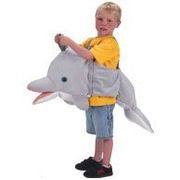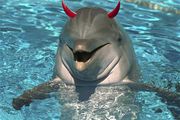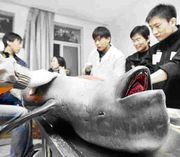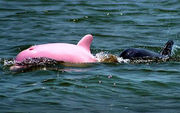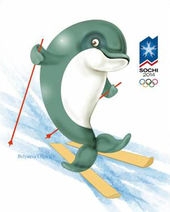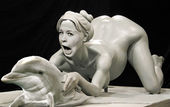Porpoise
“ What is life if it has no porpoise?”
– God on His finest creation.
“ To forget one’s porpoise is the commonest form of stupidity ”
– Freidrich Nietzsche on life.
Porpoises are small cetaceans of the family Phocoenidae; they are cousins of whales and dolphins but distant enough that inter-marriage is legal if distasteful.
Like Dolphins they are reputed to be intelligent enough to appear on the television show "Who is smarter than a fifth grader" to justify this: porpoise philosophers have limited their intellectual curiosity to fish, porpoise contributions to Science are negligible and they have constructed no buildings of architectural note since abandoning Atlantis. Porpophiles claim that the species has taken great strides in literature over recent decades, but there is little to show for their efforts due to a failure to develop non-water-soluble inks. It is unclear why the inability to stop smiling has convinced humans that porpoises are anything other than insecure, dishonest or droolingly insane.
Though not entirely computer illiterate, Porpoises were among the last species on Earth to utilise the World Wide Web. This is thought to be due to an unfortunate translation of the word “Internet” (“Squeak, squelch, beep, squelch, squeak”) as “Squeak, squelch, beep, squelch, squeak, aaarghhh!” or “Into net”.
They are distinct from dolphins, although the word "porpoise" has been used to refer to any small dolphin, especially by sailors and fishermen. Diminutive Dolphins themselves prefer the term “DORG“– Dolphin of restricted Growth or even dwarf Hell-fish as they consider porpoises to be poor cousins, the type that live on farms and only breed with each other and livestock. The most obvious visible difference between the two groups is that porpoises have flattened, spade-shaped teeth distinct from the conical teeth of dolphins, and shorter beaks. In addition, Dolphins prefer to fight with bladed weapons to utilise their longer reach, whereas porpoises have traditionally favoured firearms, despite the obvious limitations of their aquatic environment.
Most sources believe that the name porpoise derives from French pourpois, originally from Medieval Latin porcopiscus (porcus pig + piscus fish). However porpoises vigorous deny this claiming that the word derives from the Algonquin Indian word “Papoose” and refers to their habit of carrying their young on their backs while hunting Bison and selling their birthright for pretty beads.
Porpoises are divided into six species and live in all oceans, mostly near the shore and only occasionally in condominiums. Probably the best known species is the Harbour Porpoise, which can be found across the Northern Hemisphere and appears regularly in Hello and other celebrity magazines. Freshwater populations of the Finless Porpoise exist but have inherent stability problems which had led to them being referred to as “revolving dolphins”, a term they dislike. Like all toothed whales, porpoises are predators, using sounds to locate prey and to coordinate with others. They mostly hunt fish, squid, and giraffe, but when times are hard can be seen hanging around shopping malls bumming change for burgers.
Porpoises apparently diverged from dolphins about 15 million years ago due to musical differences. This is thought to have occurred in the Northern Pacific during the Japanese leg of a world tour.
Taxonomy and evolution[edit | edit source]
Porpoises, along with whales, dolphins and Meerkats, are descendants of land-living ungulates (hoofed animals) that first entered the oceans around 50 million years ago in search of then abundant varieties of sea-wheat and oceanic-rice. Having quickly over-grazed the world’s oceans, all three branches were forced to diversify their diet; porpoises and dolphins choosing fish, whales mostly opting for a shopping cart-rich diet. Meerkats are thought to have returned to the land when the sea “got a bit chilly”.
During the Miocene (23 MYA to last Tuesday), mammals were fairly modern. The cetaceans diversified, and fossil evidence suggests that porpoises diverged from dolphins and other cetaceans around 15 MYA. The oldest fossils are known from the shallow seas around the North Pacific, with animals spreading to the European coasts and the southern hemisphere only when cheaper long-haul flights became available during the Plasticene era.
Recently-discovered hybrids between male Harbour porpoises and female Dall's Porpoises indicate that the two species may actually be members of the same genus or “just not that picky”. Stick to your own kind, guys.
Physical characteristics[edit | edit source]
Porpoises tend to be smaller but stouter than dolphins. They would say “Big-boned”. They have small, rounded heads and blunt jaws instead of beaks. While dolphins have a round, bulbous melon, porpoises do not and this leads to frequent conflicts when gangs of teenage porpoises harass young dolphin girls demanding a feel of their melons. Their teeth are spade-shaped, whereas dolphins have conical teeth. In addition, a porpoise's dorsal fin is generally triangular, rather than curved like that of many dolphins. Some species have small bumps, known as tubercles, on the leading edge of the dorsal fin. The function of these bumps is unknown but they generally grow out of them after the teenage years and recent developments in the pharmaceutical industry have led to successful treatment and a lowering of the suicide-rate in adolescent porpoises.
These animals are the smallest cetaceans, reaching body lengths up to 2.5 metres (8 ft); the smallest species is the Vaquita, reaching only 1.5x10-6 m . In terms of weight the lightest is the Finless Porpoise at 30-45 grams and the heaviest is Dall's Porpoise at 130-200 tons. Because of their small size, porpoises lose body heat to the water more rapidly than other cetaceans and many now chose to wear bubble-wrap insulation at all time, except during mating-rituals and at church. Their stout shape, which minimizes surface area, may be an adaptation to reduce heat loss – or that’s what they’d like you to believe, anyway. Thick blubber also insulates them from the cold and the small size of porpoises requires them to eat frequently despite the advice of their doctors.
Life history[edit | edit source]
Porpoises are relatively r-selected compared with dolphins: that is, they bear young more quickly than dolphins. However, it is clear from the fossil record that this was not always the case and that the relatively young age of porpoise mothers is a result of the break-down of porpoise society following the introduction of social welfare reforms in the 1960s. Female Dall's and Harbour Porpoises often become pregnant with a single porpoiselet each year so long as the child-maintenance keeps coming. Porpoises generally live 80 years and there are some that are claimed to have lived to be over a hundred, though it is thought that many of these have been embalmed by their families and merely set up in electric rocking-chairs on the porch in order to claim enhanced retirement pensions for the over 90s. Many porpoises also receive invalidity benefit despite working as pole-dancers.
Reproduction[edit | edit source]
Porpoises are unusual for mammals in being able to reproduce both sexually and asexually. In general, the mating-season begins around July 1st annually and continues until approximately June 31st. Groups of up to 1500 porpoises congregate on moonlit nights at hastily arranged sites, broadcast clandestinely to avoid the interference of the authorities. Then begins a stately courtship dance known as “The stately courtship dance of the porpoise mating-season beneath the moonlit skies” or “Squeak”, in porpoise.
Estimates for the length of porpoise congress vary from the male estimate of “All fucking night, mate and then some” to the more conservative female estimate of 30 to 40 seconds, maybe a minute on a good night.” Intercourse typically involves three animals, though dozens of male porpoises crowd around the action squeaking encouragingly and throwing money at the female, while disparaging the efforts of the spit-roasting males.
Following copulation, both the males divide mitostically with a resounding “Popping" noise audible on sub-marine sonar over tens of kilometres. The female embarks on an 11 month gestation while the males pair up with their new twin to explore the homoerotic potential of cloning.
Finally, after eleven long months the female porpoise spawns, producing up to thirty bowling ball sized eggs, sometimes confused for pack ice in polar latitudes. She guards the eggs day and night for a further 6 days, keeping vigilant watch for sharks and predatory clown-fish. The hatching are co-ordinated and the female spends the next three months alternately hunting and regurgitating the squid, condoms and soiled sanitary towels that she has caught for her downy young, still too immature to take their first flight.
At the end of the three months the porpoiselets weigh up to 40% the mass of an adult and provide a filling meal for their mother, who will consume all the males and all but the feistiest of the females. Porpoises rarely consume asexually produced off-spring unless peckish.
Biologists are intrigued by porpoise behaviour and believe that they reproduce sexually for the following reasons; i) Kicks ii) Tasty genetic variety.
Behaviour[edit | edit source]
Porpoises are unfairly associated with anti-social behaviour orders (ASBOs). This is unfortunate as it is only Finless Porpoises which are actually excluded from Great Britain due to repeated public begging. “It’s not pan-handling,” a statement from Finless Porpoise Digest claimed. “It’s break-dancing for money – in France it’s called street theatre and we get a grant from the EU for it. Fucking British Immigration Nazis.”
Although they are capable of working porpoises generally hunt in packs, picking pockets at concerts and other mass social-gatherings. They are found most commonly in groups of fewer than ten individuals to avoid alerting the police and they can usually rely on “All looking the same to me, guv” to avoid identification.
Rarely, some species form brief aggregations of several hundred animals but this is almost always swiftly responded to by the riot squad before they can organise any large-scale shop-lifting. Like all toothed whales they are capable of ram-raiding in search of cigarettes and alcohol. Porpoises tend to be less acrobatic than dolphins but this is thought to be due to their habit of carrying concealed weapons in their rectum.
Porpoise economy[edit | edit source]
December 31st 1968 saw porpoises declare themselves independent of the sea and set up a Maoist collectivised government on the newly formed island of Surtsey, Iceland. Prospects for the PPP (Popular porpoise Party) government appeared bleak as Surtsey remained an actively erupting volcanic island consisting of little except sterile ash. However, the timely injection of emergency aid from the UNHCR allowed the republic to struggle on until January 3rd, 1969 by which point the PPP had cashed and laundered the aid cheque and extorted a multimillion dollar bribe from the Icelandic government to avoid conflicting claims over fishery rights.
The majority of Surtsey’s population returned swiftly to the ocean before landing in Europe to claim what was rightfully theirs under EU regulations as stateless refugees.
Human impact[edit | edit source]
Accidental entanglement (bycatch) in fishing nets is a major threat to porpoises today as is incarceration in high-security penitentiaries. One of the most endangered cetacean species is the Vaquita, having a limited distribution in the Gulf of California, where it has become embroiled in a bitter turf war with Colombian gangs for control of the cocaine market
In some countries, porpoises are hunted for food, or bait meat, or fun.
Porpoises are rarely held for long in captivity in zoos or oceanaria, as they are adept at feigning “stir-craziness” and being transferred to less secure institutions for the criminally insane. The motto of the Vaquita is said to be “Ain’t no tank gonna hold me, copper. See! Yeah!”
Porpoise culture[edit | edit source]
Porpoise culture is limited to the art of song and the simpler pleasures of television. Until recently, porpoise musical offerings have been of limited interest to the non-cetacean world. However, following the introduction of garage beats by Phat-boy Fin, porpoise music is now of limited interest to anyone.
Porpoise television has been much more successful, however, dominated though it is by soap opera and wrestling. Porpoise wrestling has a passing resemblance for the popular Japanese sport of aquatic Sumo, but the participants are uniformly attired in face-masks, spandex and capes. The competing porpoises shove each other in the hope of pushing their opponent out of the ring while their friends pick the pockets of the audience.
Porpoise soap operas are an endless source of melodrama, much enjoyed throughout the oceans. Often set in a local pub the simplistic plot-lines usually feature the unknown parentage of an egg, the unwanted love-interested of Orcas or racial disharmony among various sub-species. The most popular soaps at present are “Beastenders” and “Coronation Beast”

